化工专业英语课文翻译
- 格式:doc
- 大小:156.50 KB
- 文档页数:18
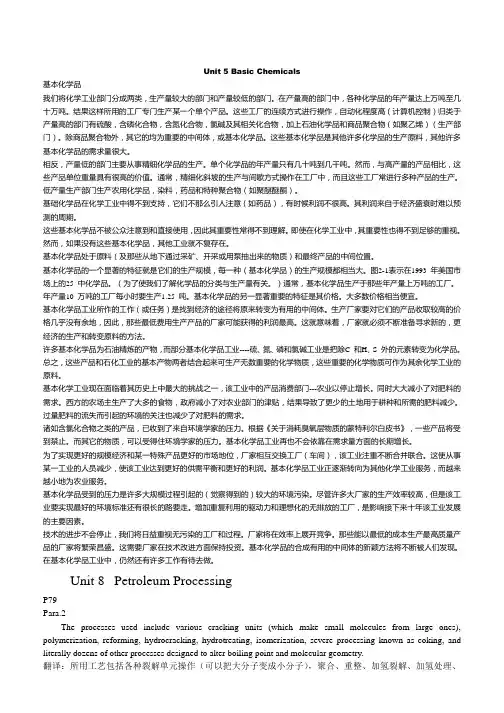
Unit 5 Basic Chemicals基本化学品我们将化学工业部门分成两类,生产量较大的部门和产量较低的部门。
在产量高的部门中,各种化学品的年产量达上万吨至几十万吨。
结果这样所用的工厂专门生产某一个单个产品。
这些工厂的连续方式进行操作,自动化程度高(计算机控制)归类于产量高的部门有硫酸,含磷化合物,含氮化合物,氯碱及其相关化合物,加上石油化学品和商品聚合物(如聚乙烯)(生产部门)。
除商品聚合物外,其它的均为重要的中间体,或基本化学品。
这些基本化学品是其他许多化学品的生产原料,其他许多基本化学品的需求量很大。
相反,产量低的部门主要从事精细化学品的生产。
单个化学品的年产量只有几十吨到几千吨。
然而,与高产量的产品相比,这些产品单位重量具有很高的价值。
通常,精细化斜坡的生产与间歇方式操作在工厂中,而且这些工厂常进行多种产品的生产。
低产量生产部门生产农用化学品,染料,药品和特种聚合物(如聚醚醚酮)。
基础化学品在化学工业中得不到支持,它们不那么引人注意(如药品),有时候利润不很高。
其利润来自于经济盛衰时难以预测的周期。
这些基本化学品不被公众注意到和直接使用,因此其重要性常得不到理解。
即使在化学工业中,其重要性也得不到足够的重视。
然而,如果没有这些基本化学品,其他工业就不复存在。
基本化学品处于原料(及那些从地下通过采矿、开采或用泵抽出来的物质)和最终产品的中间位置。
基本化学品的一个显著的特征就是它们的生产规模,每一种(基本化学品)的生产规模都相当大。
图2-1表示在1993 年美国市场上的25 中化学品。
(为了使我们了解化学品的分类与生产量有关。
)通常,基本化学品生产于那些年产量上万吨的工厂。
年产量10 万吨的工厂每小时要生产1.25 吨。
基本化学品的另一显著重要的特征是其价格。
大多数价格相当便宜。
基本化学品工业所作的工作(或任务)是找到经济的途径将原来转变为有用的中间体。
生产厂家要对它们的产品收取较高的价格几乎没有余地,因此,那些最低费用生产产品的厂家可能获得的利润最高。
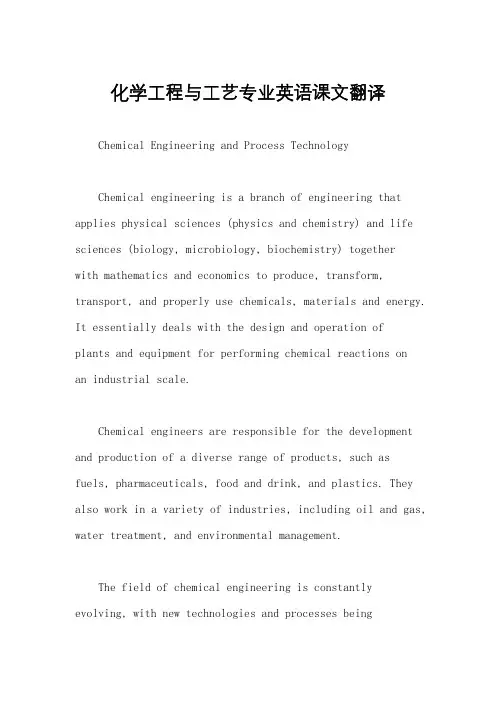
化学工程与工艺专业英语课文翻译Chemical Engineering and Process TechnologyChemical engineering is a branch of engineering that applies physical sciences (physics and chemistry) and life sciences (biology, microbiology, biochemistry) togetherwith mathematics and economics to produce, transform, transport, and properly use chemicals, materials and energy. It essentially deals with the design and operation ofplants and equipment for performing chemical reactions onan industrial scale.Chemical engineers are responsible for the development and production of a diverse range of products, such as fuels, pharmaceuticals, food and drink, and plastics. They also work in a variety of industries, including oil and gas, water treatment, and environmental management.The field of chemical engineering is constantly evolving, with new technologies and processes beingdeveloped to improve efficiency and sustainability. This requires chemical engineers to stay up-to-date with the latest developments in their field and to continually adapt their skills and knowledge.Process technology, on the other hand, focuses on the methods and techniques used to transform raw materials into useful products. This includes the design, operation, and optimization of chemical, physical, and biological processes. Process technologists work closely with chemical engineers to ensure that the processes are efficient, safe, and environmentally friendly.Some of the key areas of study within chemical engineering and process technology include thermodynamics, fluid mechanics, heat transfer, mass transfer, reaction kinetics, process control, and process design. These subjects form the foundation of the discipline and are essential for understanding and solving the complex problems that chemical engineers and process technologists face in their work.In recent years, there has been a growing emphasis on sustainability and green engineering within the field of chemical engineering and process technology. This has led to the development of new processes and technologies that minimize waste, reduce energy consumption, and limit the environmental impact of chemical production.One example of this is the use of renewable feedstocks, such as biomass, in place of traditional fossil fuels. By utilizing sustainable raw materials, chemical engineers and process technologists can help to reduce the reliance on finite resources and decrease the carbon footprint of chemical processes.Another important development in the field is the use of process intensification, which involves the integration of multiple processes into a single, more efficient system. This approach can lead to significant improvements in productivity, energy efficiency, and cost savings.As the demand for chemical products continues to grow, the role of chemical engineers and process technologists inaddressing global challenges, such as climate change and resource depletion, becomes increasingly important. By applying their knowledge and skills to develop innovative and sustainable solutions, they can help to create a more environmentally friendly and economically viable future.In conclusion, chemical engineering and process technology are dynamic and interdisciplinary fields that play a crucial role in the production of a wide range of products. With a focus on sustainability and innovation, chemical engineers and process technologists are well-positioned to address the challenges of the 21st century and contribute to the development of a more sustainable and prosperous world.。
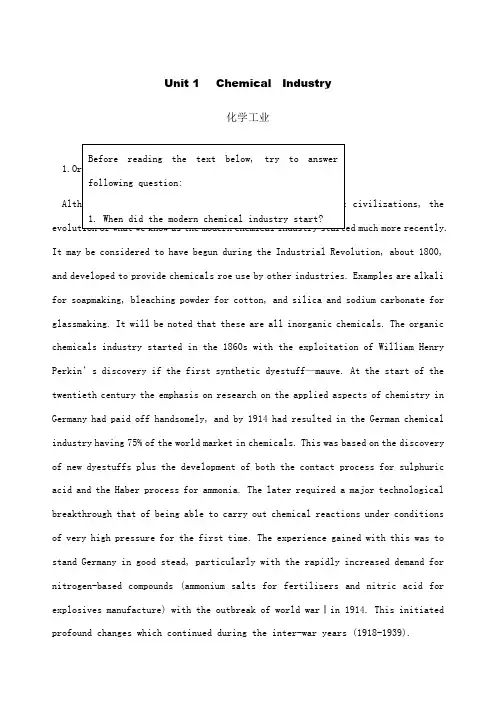
Unit 1 Chemical Industry化学工业much more recently. It may be considered to have begun during the Industrial Revolution, about 1800, and developed to provide chemicals roe use by other industries. Examples are alkali for soapmaking, bleaching powder for cotton, and silica and sodium carbonate for glassmaking. It will be noted that these are all inorganic chemicals. The organic chemicals industry started in the 1860s with the exploitation of William Henry Perkin’s discovery if the first synthetic dyestuff—mauve. At the start of the twentieth century the emphasis on research on the applied aspects of chemistry in Germany had paid off handsomely, and by 1914 had resulted in the German chemical industry having 75% of the world market in chemicals. This was based on the discovery of new dyestuffs plus the development of both the contact process for sulphuric acid and the Haber process for ammonia. The later required a major technological breakthrough that of being able to carry out chemical reactions under conditions of very high pressure for the first time. The experience gained with this was to stand Germany in good stead, particularly with the rapidly increased demand for nitrogen-based compounds (ammonium salts for fertilizers and nitric acid for explosives manufacture) with the outbreak of world warⅠin 1914. This initiated profound changes which continued during the inter-war years (1918-1939).1.化学工业的起源尽管化学品的使用可以追溯到古代文明时代,我们所谓的现代化学工业的发展却是非常近代(才开始的)。
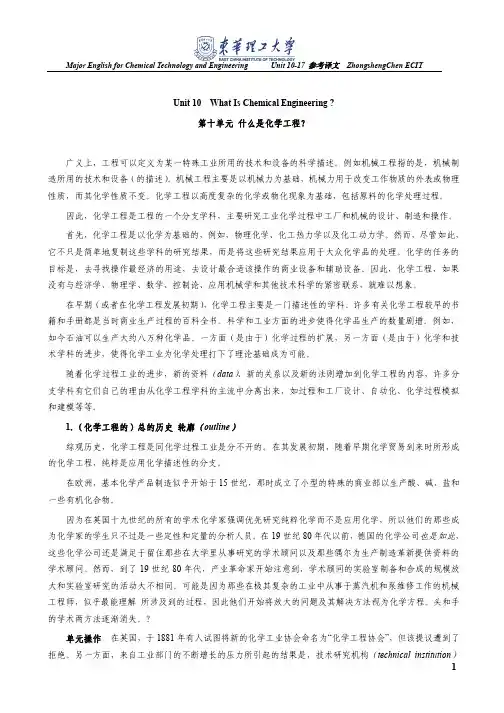
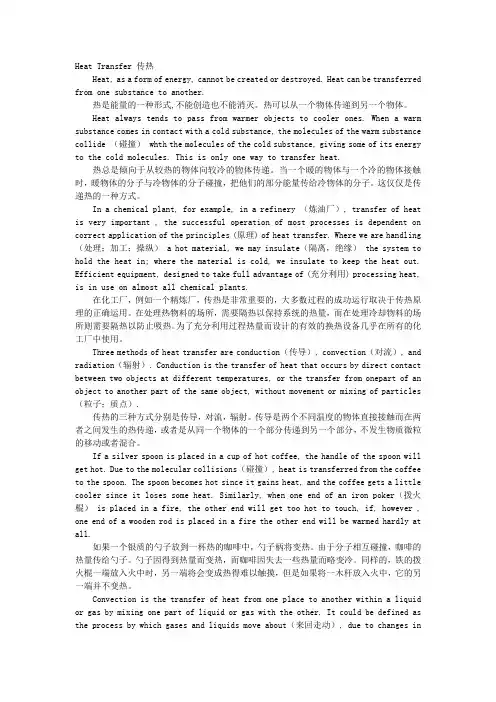
Heat Transfer 传热Heat, as a form of energy, cannot be created or destroyed. Heat can be transferred from one substance to another.热是能量的一种形式,不能创造也不能消灭。
热可以从一个物体传递到另一个物体。
Heat always tends to pass from warmer objects to cooler ones. When a warm substance comes in contact with a cold substance, the molecules of the warm substance collide (碰撞) whth the molecules of the cold substance, giving some of its energy to the cold molecules. This is only one way to transfer heat.热总是倾向于从较热的物体向较冷的物体传递。
当一个暖的物体与一个冷的物体接触时,暖物体的分子与冷物体的分子碰撞,把他们的部分能量传给冷物体的分子。
这仅仅是传递热的一种方式。
In a chemical plant, for example, in a refinery (炼油厂), transfer of heat is very important , the successful operation of most processes is dependent on correct application of the principles (原理) of heat transfer. Where we are handling (处理;加工;操纵) a hot material, we may insulate(隔离,绝缘) the system to hold the heat in; where the material is cold, we insulate to keep the heat out. Efficient equipment, designed to take full advantage of (充分利用) processing heat, is in use on almost all chemical plants.在化工厂,例如一个精炼厂,传热是非常重要的,大多数过程的成功运行取决于传热原理的正确运用。

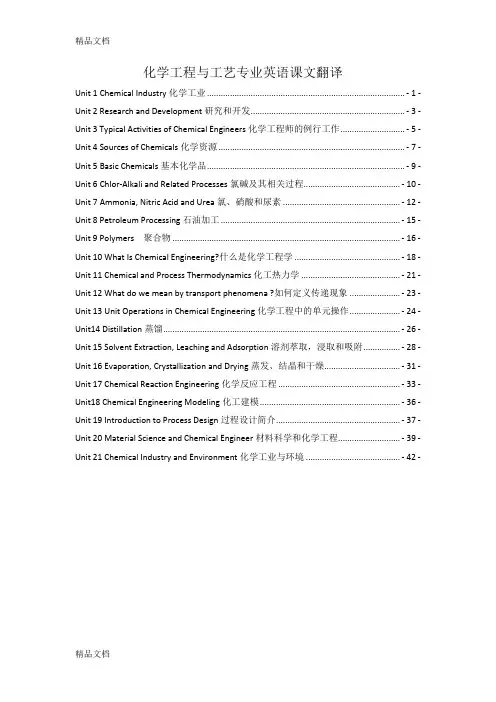
化学工程与工艺专业英语课文翻译Unit 1 Chemical Industry化学工业 ...................................................................................... - 1 -Unit 2 Research and Development研究和开发................................................................... - 3 -Unit 3 Typical Activities of Chemical Engineers化学工程师的例行工作............................ - 5 -Unit 4 Sources of Chemicals化学资源 ................................................................................. - 7 -Unit 5 Basic Chemicals基本化学品...................................................................................... - 9 -Unit 6 Chlor-Alkali and Related Processes氯碱及其相关过程.......................................... - 10 -Unit 7 Ammonia, Nitric Acid and Urea氯、硝酸和尿素 ................................................... - 12 -Unit 8 Petroleum Processing石油加工 .............................................................................. - 15 -Unit 9 Polymers 聚合物 ................................................................................................... - 16 -Unit 10 What Is Chemical Engineering?什么是化学工程学 .............................................. - 18 -Unit 11 Chemical and Process Thermodynamics化工热力学 ........................................... - 21 -Unit 12 What do we mean by transport phenomena ?如何定义传递现象 ...................... - 23 -Unit 13 Unit Operations in Chemical Engineering化学工程中的单元操作...................... - 24 -Unit14 Distillation蒸馏....................................................................................................... - 26 -Unit 15 Solvent Extraction, Leaching and Adsorption溶剂萃取,浸取和吸附................ - 28 -Unit 16 Evaporation, Crystallization and Drying蒸发、结晶和干燥................................. - 31 -Unit 17 Chemical Reaction Engineering化学反应工程 ..................................................... - 33 -Unit18 Chemical Engineering Modeling化工建模 ............................................................. - 36 -Unit 19 Introduction to Process Design过程设计简介...................................................... - 37 -Unit 20 Material Science and Chemical Engineer材料科学和化学工程........................... - 39 -Unit 21 Chemical Industry and Environment化学工业与环境 ......................................... - 42 -Unit 1 Chemical Industry化学工业1.化学工业的起源尽管化学品的使用可以追溯到古代文明时代,我们所谓的现代化学工业的发展却是非常近代(才开始的)。
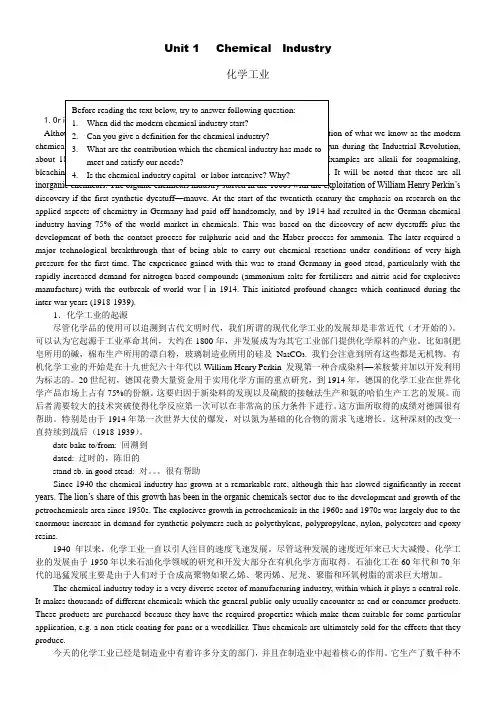
Unit 1 Chemical Industry化学工业during the Industrial Revolution, about are alkali for soapmaking,It will be noted that these are alldiscovery if the first synthetic dyestuff—mauve. At the start of the twentieth century the emphasis on research on the applied aspects of chemistry in Germany had paid off handsomely, and by 1914 had resulted in the German chemical industry having 75% of the world market in chemicals. This was based on the discovery of new dyestuffs plus the development of both the contact process for sulphuric acid and the Haber process for ammonia. The later required a major technological breakthrough that of being able to carry out chemical reactions under conditions of very high pressure for the first time. The experience gained with this was to stand Germany in good stead, particularly with the rapidly increased demand for nitrogen-based compounds (ammonium salts for fertilizers and nitric acid for explosives manufacture) with the outbreak of world warⅠin 1914. This initiated profound changes which continued during the inter-war years (1918-1939).1.化学工业的起源尽管化学品的使用可以追溯到古代文明时代,我们所谓的现代化学工业的发展却是非常近代(才开始的)。
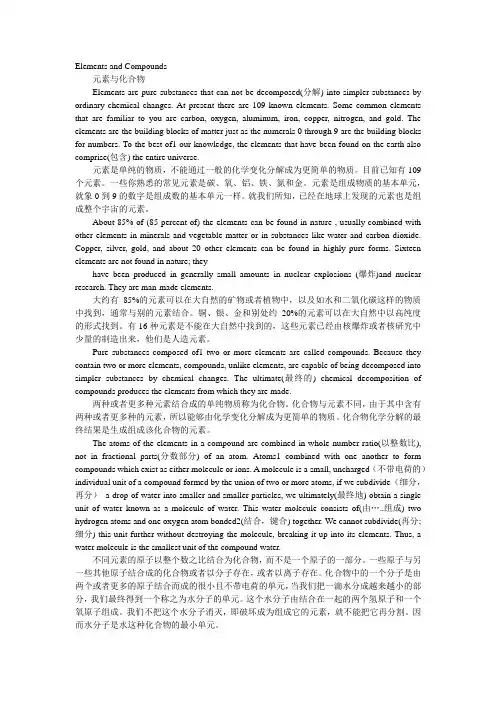
Elements and Compounds元素与化合物Elements are pure substances that can not be decomposed(分解) into simpler substances by ordinary chemical changes. At present there are 109 known elements. Some common elements that are familiar to you are carbon, oxygen, aluminum, iron, copper, nitrogen, and gold. The elements are the building blocks of matter just as the numerals 0 through 9 are the building blocks for numbers. To the best of1 our knowledge, the elements that have been found on the earth also comprise(包含) the entire universe.元素是单纯的物质,不能通过一般的化学变化分解成为更简单的物质。
目前已知有109个元素。
一些你熟悉的常见元素是碳、氧、铝、铁、氮和金。
元素是组成物质的基本单元,就象0到9的数字是组成数的基本单元一样。
就我们所知,已经在地球上发现的元素也是组成整个宇宙的元素。
About 85% of (85 percent of) the elements can be found in nature , usually combined with other elements in minerals and vegetable matter or in substances like water and carbon dioxide. Copper, silver, gold, and about 20 other elements can be found in highly pure forms. Sixteen elements are not found in nature; theyhave been produced in generally small amounts in nuclear explosions (爆炸)and nuclear research. They are man-made elements.大约有85%的元素可以在大自然的矿物或者植物中,以及如水和二氧化碳这样的物质中找到,通常与别的元素结合。
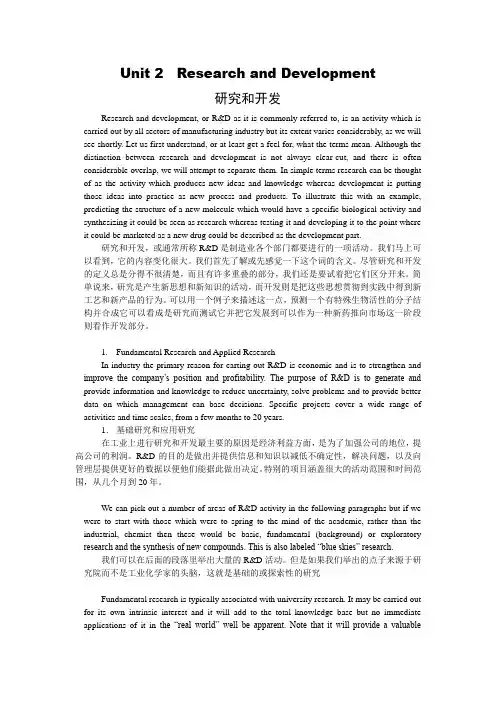
Unit 2 Research and Development研究和开发Research and development, or R&D as it is commonly referred to, is an activity which is carried out by all sectors of manufacturing industry but its extent varies considerably, as we will see shortly. Let us first understand, or at least get a feel for, what the terms mean. Although the distinction between research and development is not always clear-cut, and there is often considerable overlap, we will attempt to separate them. In simple terms research can be thought of as the activity which produces new ideas and knowledge whereas development is putting those ideas into practice as new process and products. To illustrate this with an example, predicting the structure of a new molecule which would have a specific biological activity and synthesizing it could be seen as research whereas testing it and developing it to the point where it could be marketed as a new drug could be described as the development part.研究和开发,或通常所称R&D是制造业各个部门都要进行的一项活动。
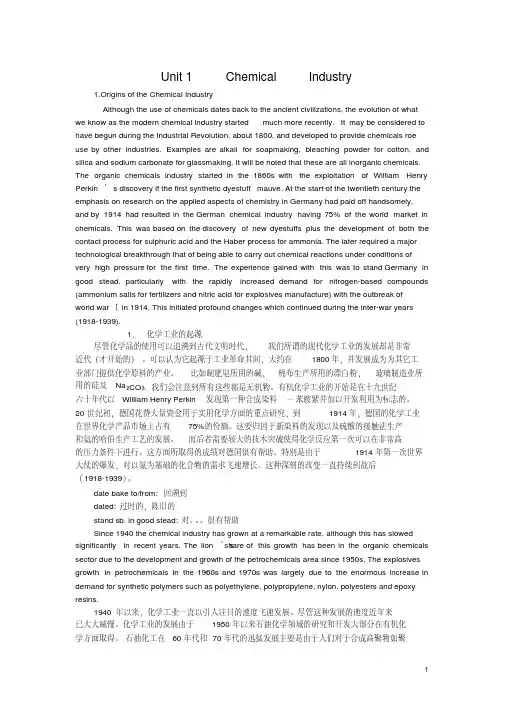
Unit 1 Chemical Industry1.Origins of the Chemical IndustryAlthough the use of chemicals dates back to the ancient civilizations, the evolution of what we know as the modern chemical industry started much more recently. It may be considered to have begun during the Industrial Revolution, about 1800, and developed to provide chemicals roe use by other industries. Examples are alkali for soapmaking, bleaching powder for cotton, and silica and sodium carbonate for glassmaking. It will be noted that these are all inorganic chemicals. The organic chemicals industry started in the 1860s with the exploitation of William Henrymauve. At the start of the twentieth century the Perkin’s discovery if the first synthetic dyestuff—emphasis on research on the applied aspects of chemistry in Germany had paid off handsomely, and by 1914 had resulted in the German chemical industry having 75% of the world market in chemicals. This was based on the discovery of new dyestuffs plus the development of both the contact process for sulphuric acid and the Haber process for ammonia. The later required a major technological breakthrough that of being able to carry out chemical reactions under conditions of very high pressure for the first time. The experience gained with this was to stand Germany in good stead, particularly with the rapidly increased demand for nitrogen-based compounds (ammonium salts for fertilizers and nitric acid for explosives manufacture) with the outbreak ofworld warⅠin 1914. This initiated profound changes which continued during the inter-war years (1918-1939).1.化学工业的起源尽管化学品的使用可以追溯到古代文明时代,我们所谓的现代化学工业的发展却是非常近代(才开始的)。
Unit 1 Chemical Industry1.Origins of the Chemical IndustryAlthough the use of chemicals dates back to the ancient civilizations, the evolution of what we know as the modern chemical industry started much more recently. It may be considered to have begun during the Industrial Revolution, about 1800, and developed to provide chemicals roe use by other industries. Examples are alkali for soapmaking, bleaching powder for cotton, and silica and sodium carbonate for glassmaking. It will be noted that these are all inorganic chemicals. The organic chemicals industry started in the 1860s with the exploitation of William Henry Perkin’s discovery if the first synthetic dyestuff—mauve. At the start of the twentieth century the emphasis on research on the applied aspects of chemistry in Germany had paid off handsomely, and by 1914 had resulted in the German chemical industry having 75% of the world market in chemicals. This was based on the discovery of new dyestuffs plus the development of both the contact process for sulphuric acid and the Haber process for ammonia. The later required a major technological breakthrough that of being able to carry out chemical reactions under conditions of very high pressure for the first time. The experience gained with this was to stand Germany in good stead, particularly with the rapidly increased demand for nitrogen-based compounds (ammonium salts for fertilizers and nitric acid for explosives manufacture) with the outbreak of world warⅠin 1914. This initiated profound changes which continued during the inter-war years (1918-1939).1.化学工业的起源尽管化学品的使用可以追溯到古代文明时代,我们所谓的现代化学工业的发展却是非常近代(才开始的)。
Unit 1 Chemical Industry化学工业1.Origins of the Chemical IndustryAlthough the use of chemicals dates back to the ancient civilizations, the evolution of what we know as the modern chemical industry started much more recently. It may be considered to have begun during the Industrial Revolution, about 1800, and developed to provide chemicals roe use by other industries. Examples are alkali for soapmaking, bleaching powder for cotton, and silica and sodium carbonate for glassmaking. It will be noted that these are all inorganic chemicals. The organic chemicals industry started in the 1860s with the exploitation of William Henry Perkin’s discovery if the first synthetic dyestuff—mauve. At the start of the twentieth century the emphasis on research on the applied aspects of chemistry in Germany had paid off handsomely, and by 1914 had resulted in the German chemical industry having 75% of the world market in chemicals. This was based on the discovery of new dyestuffs plus the development of both the contact process for sulphuric acid and the Haber process for ammonia. The later required a major technological breakthrough that of being able to carry out chemical reactions under conditions of very high pressure for the first time. The experience gained with this was to stand Germany in good stead, particularly with the rapidly increased demand for nitrogen-based compounds (ammonium salts for fertilizers and nitric acid for explosives manufacture) with the outbreak of world warⅠin 1914. This initiated profound changes which continued during the inter-war years (1918-1939).1.化学工业的起源尽管化学品的使用可以追溯到古代文明时代,我们所谓的现代化学工业的发展却是非常近代(才开始的)。
The Anatomy of a Chemical Manufacturing Process 化工生产过程构成The basic components of a typical chemical process(n过程;步骤;方法;工艺,vt 加工;处理) are shown in Fig.1, in which each block represents a stage in the overall process for producing a product from the raw materials. Fig.1 represents a generalized(无显著特点的,一般的) process; not all the stages(步骤;阶段) will be needed for any particular(特定的) process and the complexity of each stage will depend on the nature of the process. Chemical engineering design is concerned with the selection and arrangement(排列;安排)of the stages, and the selection, specification and design of the equipment required to perform(演出;执行;完成任务) the stage functions.典型的化学工艺的基本构成示于图1., 在此图中,每一个方框表示从原料到加工成产品的全过程中的一个步骤。
图1所示只是一般的情况,对于一个特定的工艺来说并非所有的步骤都是必需的,而且每一个步骤的复杂程度取决于生产过程的性质。
化工设计所关注的是各步骤的选择与安排,以及完成各步骤的任务所需设备的选择、说明和设计。
Unit 1 Chemical Industry化学工业1.Origins of the Chemical IndustryAlthough the use of chemicals dates back to the ancient civilizations, the evolution of what we know as the modern chemical industry started much more recently. It may be considered to have begun during the Industrial Revolution, about 1800, and developed to provide chemicals roe use by other industries. Examples are alkali for soapmaking, bleaching powder for cotton, and silica and sodium carbonate for glassmaking. It will be noted that these are all inorganic chemicals. The organic chemicals industry started in the 1860s with the exploitation of William Henry Perkin’s discovery if the first synthetic dyestuff—mauve. At the start of the twentieth century the emphasis on research on the applied aspects of chemistry in Germany had paid off handsomely, and by 1914 had resulted in the German chemical industry having 75% of the world market in chemicals. This was based on the discovery of new dyestuffs plus the development of both the contact process for sulphuric acid and the Haber process for ammonia. The later required a major technological breakthrough that of being able to carry out chemical reactions under conditions of very high pressure for the first time. The experience gained with this was to stand Germany in good stead, particularly with the rapidly increased demand for nitrogen-based compounds (ammonium salts for fertilizers and nitric acid for explosives manufacture) with the outbreak of world warⅠin 1914. This initiated profound changes which continued during the inter-war years (1918-1939).1.化学工业的起源尽管化学品的使用可以追溯到古代文明时代,我们所谓的现代化学工业的发展却是非常近代(才开始的)。
Unit 10 What Is Chemical Engineering?什么是化学工程学In a wider sense, engineering may be defined as a scientific presentation of the techniques and facilities used in a particular industry. For example, mechanical engineering refers to the techniques and facilities employed to make machines. It is predominantly based on mechanical forces which are used to change the appearance and/or physical properties of the materials being worked, while their chemical properties are left unchanged. Chemical engineering encompasses the chemical processing of raw materials, based on chemical and physico-chemical phenomena of high complexity.广义来讲,工程学可以定义为对某种工业所用技术和设备的科学表达。
例如,机械工程学涉及的是制造机器的工业所用技术和设备。
它优先讨论的是机械力,这种作用力可以改变所加工对象的外表或物理性质而不改变其化学性质。
化学工程学包括原材料的化学过程,以更为复杂的化学和物理化学现象为基础。
Thus, chemical engineering is that branch of engineering which is concerned with the study of the design, manufacture, and operation of plant and machinery in industrial chemical processes.因此,化学工程学是工程学的一个分支,它涉及工业化化学过程中工厂和机器的设计、制造、和操作的研究。
Unit1Chemical Industry化学工业1.Origins ofthe Chemical IndustryAlthoughthe useof chemicals dates backtothe ancient civilizations, the evolutionof whatwe know as themodern chemical industry started much more recently. It may be considered to have begun during the IndustrialRevolution, about 1800, and developedto provide chemicalsroe use by other industries. Examples are alkali for soapmaking,bleaching powder for cotton,and silica andsodium carbonate forglassmaking. It will be noted thatthese areall inorganic chemicals. Theorganic chemicals industry startedin the1860s with theexploitationof WilliamHenry Perkin’sdiscover yif thefirst synthetic dyestuff—mauve. At thestart ofthe twen tiethcentury the emphasis on research on the applied aspects of chemistry in Germany had paidoff handsomely,andby 1914had resulted in the German chemicalindustryhaving75% ofthe worldmarketinche micals.Thiswas basedon the discoveryof new dyestuffs plus the development of boththe contactprocess forsulphuric acid and theHaberprocess for ammonia.Thelater required a majortechnological breakthroughthat of being ableto carry outchemical reactions under conditionsof veryhigh pressure forthe firsttime.The experience gained withthis was tostand Germany ingood stead, particularly with the rapidly increased demandfor nitrogen-based compounds(ammonium salts forfertilizers andnitric acid for explosives manufacture)with theoutbreakof world warⅠin 1914. This initiated profound changeswhich continued duringthe inter-war years (1918-1939).1.化学工业的起源尽管化学品的使用可以追溯到古代文明时代,我们所谓的现代化学工业的发展却是非常近代(才开始的)。
Unit 5 Basic Chemicals基本化学品我们将化学工业部门分成两类,生产量较大的部门和产量较低的部门。
在产量高的部门中,各种化学品的年产量达上万吨至几十万吨。
结果这样所用的工厂专门生产某一个单个产品。
这些工厂的连续方式进行操作,自动化程度高(计算机控制)归类于产量高的部门有硫酸,含磷化合物,含氮化合物,氯碱及其相关化合物,加上石油化学品和商品聚合物(如聚乙烯)(生产部门)。
除商品聚合物外,其它的均为重要的中间体,或基本化学品。
这些基本化学品是其他许多化学品的生产原料,其他许多基本化学品的需求量很大。
相反,产量低的部门主要从事精细化学品的生产。
单个化学品的年产量只有几十吨到几千吨。
然而,与高产量的产品相比,这些产品单位重量具有很高的价值。
通常,精细化斜坡的生产与间歇方式操作在工厂中,而且这些工厂常进行多种产品的生产。
低产量生产部门生产农用化学品,染料,药品和特种聚合物(如聚醚醚酮)。
基础化学品在化学工业中得不到支持,它们不那么引人注意(如药品),有时候利润不很高。
其利润来自于经济盛衰时难以预测的周期。
这些基本化学品不被公众注意到和直接使用,因此其重要性常得不到理解。
即使在化学工业中,其重要性也得不到足够的重视。
然而,如果没有这些基本化学品,其他工业就不复存在。
基本化学品处于原料(及那些从地下通过采矿、开采或用泵抽出来的物质)和最终产品的中间位置。
基本化学品的一个显著的特征就是它们的生产规模,每一种(基本化学品)的生产规模都相当大。
图2-1表示在1993 年美国市场上的25 中化学品。
(为了使我们了解化学品的分类与生产量有关。
)通常,基本化学品生产于那些年产量上万吨的工厂。
年产量10 万吨的工厂每小时要生产1.25 吨。
基本化学品的另一显著重要的特征是其价格。
大多数价格相当便宜。
基本化学品工业所作的工作(或任务)是找到经济的途径将原来转变为有用的中间体。
生产厂家要对它们的产品收取较高的价格几乎没有余地,因此,那些最低费用生产产品的厂家可能获得的利润最高。
这就意味着,厂家就必须不断准备寻求新的,更经济的生产和转变原料的方法。
许多基本化学品为石油精炼的产物,而部分基本化学品工业----硫、氮、磷和氯碱工业是把除C 和H、S 外的元素转变为化学品。
总之,这些产品和石化工业的基本产物两者结合起来可生产无数重要的化学物质,这些重要的化学物质可作为其余化学工业的原料。
基本化学工业现在面临着其历史上中最大的挑战之一,该工业中的产品消费部门---农业以停止增长。
同时大大减小了对肥料的需求。
西方的农场主生产了大多的食物,政府减小了对农业部门的津贴,结果导致了更少的土地用于耕种和所需的肥料减少。
过量肥料的流失而引起的环境的关注也减少了对肥料的需求。
诸如含氯化合物之类的产品,已收到了来自环境学家的压力。
根据《关于消耗臭氧层物质的蒙特利尔白皮书》,一些产品将受到禁止。
而其它的物质,可以受得住环境学家的压力。
基本化学品工业再也不会依靠在需求量方面的长期增长。
为了实现更好的规模经济和某一特殊产品更好的市场地位,厂家相互交换工厂(车间),该工业注重不断合并联合。
这使从事某一工业的人员减少,使该工业达到更好的供需平衡和更好的利润。
基本化学品工业正逐渐转向为其他化学工业服务,而越来越小地为农业服务。
基本化学品受到的压力是许多大规模过程引起的(觉察得到的)较大的环境污染。
尽管许多大厂家的生产效率较高,但是该工业要实现最好的环境标准还有很长的路要走。
增加重复利用的驱动力和理想化的无排放的工厂,是影响接下来十年该工业发展的主要因素。
技术的进步不会停止,我们将日益重视无污染的工厂和过程。
厂家将在效率上展开竞争。
那些能以最低的成本生产最高质量产品的厂家将繁荣昌盛。
这需要厂家在技术改进方面保持投资。
基本化学品的合成有用的中间体的新颖方法将不断被人们发现。
在基本化学品工业中,仍然还有许多工作有待去做。
Unit 8 Petroleum ProcessingP79Para.2The processes used include various cracking units (which make small molecules from large ones), polymerization, reforming, hydrocracking, hydrotreating, isomerization, severe processing known as coking, and literally dozens of other processes designed to alter boiling point and molecular geometry.翻译:所用工艺包括各种裂解单元操作(可以把大分子变成小分子),聚合、重整、加氢裂解、加氢处理、异构化、像焦化这种苛刻的工艺和很多旨在改变沸点和分子几何形态的其它很多工艺。
1.Constituents of PetroleumPara.1No one constituent exists in large quantity in any crude.翻译:没有一种组分在原油中大量存在。
Para.3These branched chain materials perform better in internal-combustion engines than n-paraffins and hence are considered more desirable.翻译:这些支链物在内燃发动机里的使用性能比直链的好,因此认为它们更理想。
P80Lesser ComponentsPara.2With the general adoption of catalytic cracking and finishing processes, it was discovered that the occurrence of metals present only in traces (Fe,Mo,Na,Ni,V,etc.) was troublesome as they are strong catalyst poisons.翻译:随着普遍接受了催化裂化和后处理工艺,发现金属只是痕量存在也很麻烦,因为它们是很强的使催化剂中毒的物质。
2. Products of RefiningPara.6Dealkylation of a selected reformate stream using chromate-aluminum carbide catalyst gives a product which is purified to be purer than that formed form coal tar.翻译:用铬酸铝碳化催化剂的选择性重整产品的烷基化产生的产品经提纯后的纯度比用煤焦油的高。
Reading Material 8:Coal-Conversion ProcessesP86Line 4The nature of the organic species present depends on the degree of biochemical change of the original plant material, on the historic pressures and temperatures after the initial biochemical degradation, and on the finely divided mineral matter deposited either at the same time as the plant material or later.翻译:存在的有机样的性质和最初植物的生物化学变化程度有关,和初始生化降解后那个历史时期的压力和温度有关,和很细的沉积矿物质有关(它们同时或在其后沉积)。
和很细的同时或随后沉积的矿物质有关。
P87Coal Processing to Synthetic Fuels and Other ProductsLow Temperature Carbonization.Lower temperature carbonization of lump coal at ca 700℃primarily used for production of solid smokeless fuel, gives a quantitatively and qualitatively different yield of solid, liquid, and gaseous products than does the high temperature processes.翻译:低温干馏块煤基本在大约700℃用来生产固体无烟燃料,产生的固液气产品的性质和量都不同于高温工艺。
P88LiquefactionFor the resulting liquids to be suitable chemical feedstocks the H:C ratio must be improved in favor of more hydrogen. Clearly this can be achieved in two ways—either by adding hydrogen or by removing carbon.翻译:对于最终适合作化学原料的液体,H:C的比例需提高氢占的量。
显然要提高氢占的量有两种途径——增加氢或去除碳。
Surface Gasification technologyLine 3In the United States, the purpose of a number of programs has shifted from production of a substitute natural gas (methane) to electric power generation through the integrated gasification-combined-cycle (IGCC) plants.翻译:在美国,很多工作的目的通过联合气化循环工厂已从取代天然气到发电。
Line 5The interest in this use of coal results from the low emission levels that can be achieved and the potential for higher power generation efficiency.翻译:使用煤的兴趣来自可取得较低的发热水平和潜在的高效发电率。